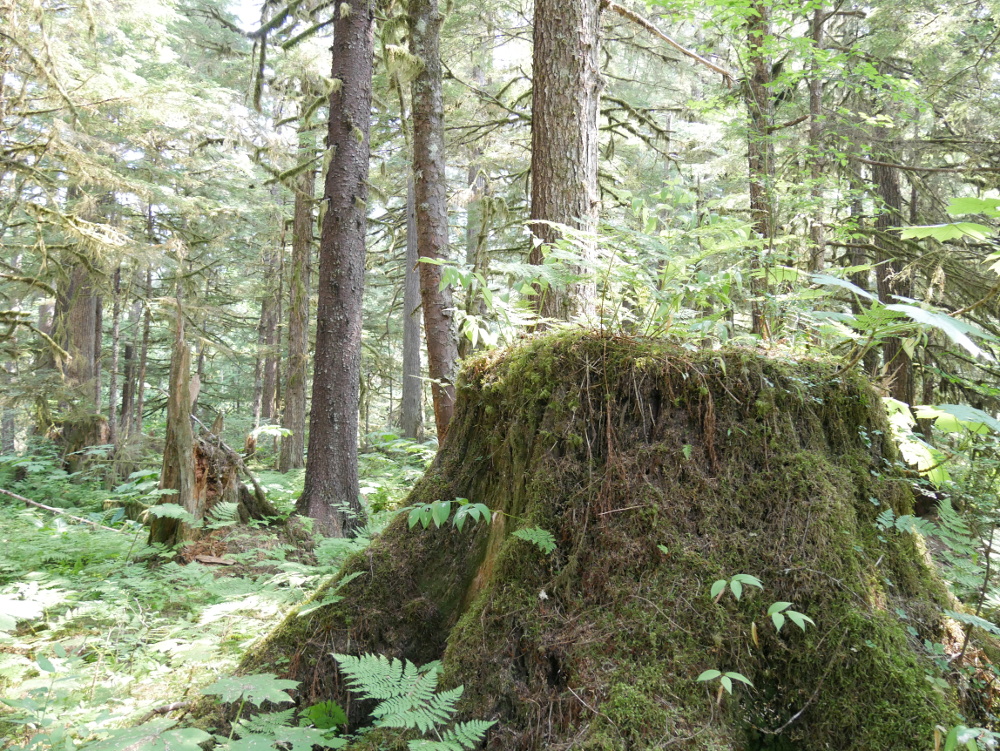
A public comment period is ending soon on proposed logging, recreation and stream work on the Tongass National Forest near Petersburg, Wrangell and Kake. The Central Tongass Project could supply old growth timber for Southeast’s logging industry. But the U.S. Forest Service continues to face questions about a lack of specifics for its most recent logging plans.
A draft environmental impact statement outlines potential logging and tree thinning, road building and culvert replacement, stream restoration, weed removal along with cabin and trail work on the 3.7 million acres of the Petersburg and Wrangell Ranger Districts of the Tongass.
Acting forest supervisor Troy Heithecker explained the scope of the project during a public meeting in Petersburg.
“It’s covering four primary project areas and those are watershed restoration, recreation management, vegetation management and access management,” Heithecker said.
The document looks at possible logging of up to 150 million board feet of old growth timber around over the next 15 years. Another 80 million board feet of young-growth timber could be cut over the same time.
Logging and related jobs from harvest of old growth trees are expected to total around 459-582 for the two action alternatives, with an estimated 28-34 million dollars in direct income. Harvest of young growth trees, sent to sawmills outside of Southeast Alaska, could bring another 229-250 jobs.
This project and one before it on Prince of Wales Island are being reviewed by the agency using a process called conditions-based NEPA. That stands for the National Environmental Policy Act, federal law that requires agencies to consider impacts from uses of national forest land. Unlike past projects on the Tongass, the agency is listing all possible work, including a pool of possible timber harvest lands. It’s not until after the agency has sought public comment and approved an environmental review that it decides the specifics on the work that will happen. That same approach, already used elsewhere in the nation, generated a lawsuit for the Prince of Wales project.
Heithecker was asked whether this Environmental Impact Statement, or EIS would also wind up in court.
“Depending on your interpretation of risky or controversial, pretty much any EIS involving timber harvest on the Tongass gets litigated,” Heithecker said. “So at some level we realize we’re probably going to end up there anyway. So changing the format to try and clear the longer time frame with NEPA so that we’re not just always in the planning phase, that we have some shelf stocks, so to speak, of NEPA, allows us to implement projects, is kind of why we’re going with this method.”
This method basically outlines the broadest footprint the agency envisions could happen under this environmental document. But stakeholders and residents say it makes it more difficult to submit public comments.
“People care about the places they use for subsistence and how the action will affect those places in nearby habitat,” said Heather Evoy, indigenous engagement lead for the Southeast Alaska Conservation Council, a regional environmental organization headquartered in Juneau. “Displaying one giant map covering millions of acres of which nearly 43,000 acres may be logged anywhere with the over 82,000 acres suitable for logging conveys next to nothing about what might actually happen or how the project will impact wildlife and people or what the alternatives might be minimize those impacts.”
Evoy spoke during a required hearing on subsistence use of deer and other plants and animals from the forest. The agency’s analysis says the proposed logging may contribute to future restriction on subsistence hunting for deer.
As part of the project the agency is proposing to lower scenery standards set in the 2016 management plan for the Tongass in order to allow more clear-cut logging in parts of the project area.
The revenue from timber sales could pay for the recreation and habitat work. And that approach has prompted concern over past logging on Prince of Wales and Kupreanof Island also meant to fund this stewardship work.
Heithecker repeated assurances from top officials that problems with appraisal and oversight have been fixed.
“We’re still in the analysis here,” Heithecker said. “We have no idea, well we have an idea because there’s only a few vessels for doing that sort of work, but we don’t know if it’s going to be stewardship contracting, straight timber sale contracting, if we’re going to do restoration agreements with partners, there’s a lot of unknowns. What I would say about the press and media we’ve had on that, it’s the same thing the regional forester stated, we’ve had several multiple audits now on this and we have made adjustments and are ensuring that as we move forward that those are, any of the issues that brought up in those audits are accounted for and are adjusted.”
A 45-day comment period ends September 16th. A decision on the project could be out sometime next year.









